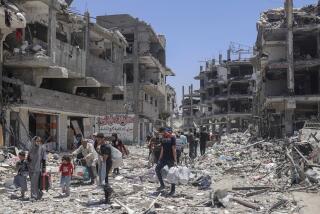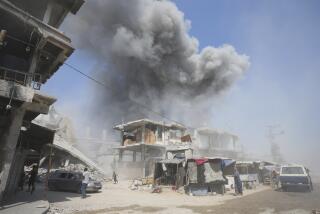Gaza tunnels a big hurdle for Israelis
WASHINGTON AND RAFAH, EGYPT — Some of them are said to be big enough to accommodate railroad cars. They may reach a depth of 60 feet, and are reported to be equipped with cables and electric motors that move food, fuel -- and probably some of the heaviest rockets that Hamas aims at Israel.
They also are one of the main reasons fighting is continuing in the Gaza Strip.
As Israeli officials debate how far to press their campaign in Gaza, one of their chief goals is finding a way to crimp or permanently halt the flow of arms to Hamas through a complex of tunnels under the territory’s border with Egypt.
While ground forces battle Hamas fighters in the streets, Israeli warplanes have pummeled targets in Gaza near Rafah, the town that straddles the Gaza-Egypt border. Israel’s demand to block arms shipments through the so-called Philadelphi corridor, the strip of land separating Gaza and Egypt, is a central point in cease-fire talks.
“The tunnels are important, probably to the point that a preponderance of weapons have come through those tunnels,” said a senior U.S. military official who has seen classified intelligence reports on Hamas arms flows.
For residents of Gaza, however, the tunnels bring far more than arms. The territory’s borders have largely been sealed since Hamas took control of the territory in 2007. The tunnels are the main conduit for normal commerce and a lifeline for food and medicine.
Smuggling through the tunnels is also a primary source of income for Bedouin tribes long neglected by the Egyptian government. One smuggler, who gave his name only as Abu Mohammed, said that gasoline and food made up the bulk of his business.
Palestinians involved in cease-fire negotiations want to see the overland border with Egypt reopened. “As long as there’s a blockade around Gaza, the tunnels will remain,” Abu Mohammed said.
On the Israeli side, military officials and politicians have made clear that they see the blocking of the tunnels as a prerequisite to any cease-fire.
“We must reach, at the end of the war, a situation in which this arms smuggling is stopped,” Yossi Peled, a general in the Israeli reserves and former head of the Israel Defense Forces’ northern command, said this week on Israeli radio. “If we do not achieve this, then one might very well ask why it was that we embarked on this war to begin with.”
Shutting the tunnels by military force alone is likely to be difficult. Israel had only limited success even when it controlled the Gaza Strip. Analysts who have been briefed on Israeli intelligence say the tunnels have become more elaborate in the 3 1/2 years since Israel pulled out of Gaza.
A U.S. government study issued last year reported that Egyptian officials had privately acknowledged that 10 to 30 main tunnel shafts run underneath the border at any one time.
Longer-range, Iranian-made missiles, such as the Grad rockets that struck the Israeli town of Ashkelon in May, are relatively large weapons that could be moved only through tunnels of considerable scale, according to one former Pentagon official. Some of the tunnels are large enough to run rail cars under the border, according to people who have been briefed by Israeli officials, although it’s unclear whether rail cars are used.
Wealthy families in Rafah allow either their private homes or rental properties to be used as tunnel openings, which are then rented out to Hamas gunrunners.
“When a tunnel is completed, the primary investor and his/her relatives are entitled to a percentage on every shipment passing through it,” according to the 2008 report, compiled by the Congressional Research Service. “Packages of arms and ammunition are pulled by cables and electric motors through the tunnels, which in some places reportedly reach depths of 50 and 60 feet in order to avoid detection.”
Abu Mohammed, the Egyptian smuggler, said this week that Israel’s airstrikes had damaged as much as 60% of the tunnels, but that the damage could be repaired easily. He said the tunnels range in depth from 39 to 49 feet, and that Israeli missiles can penetrate to a depth of only 24 feet.
As a result, U.S. and Israeli experts say any effort to permanently shut down the tunnels is likely to focus on a diplomatic agreement with Egypt, which since Israel’s withdrawal from Gaza has largely shouldered the responsibility for policing the border crossing.
The growth of the tunnel network, however, has prompted critics, including some in the U.S. Congress, to doubt whether Egypt has done enough.
“The question is whether this is a matter of capability, that Egypt can’t counter these tunnels, or is it a matter of some degree of tolerance for these tunnels to demonstrate sympathy with the Palestinians?” said David Schenker, who until recently handled Palestinian issues at the Pentagon.
Egyptian officials say current agreements with Israel permit only 750 Egyptian border guards to monitor the crossing. One Egyptian official said Cairo has repeatedly asked to increase the number, only to be rebuffed by Israel.
In addition, U.S. and Egyptian officials said that the combination of a vast desert surrounding a densely populated city makes it easy for smugglers to mask their movements.
“When the Israelis were in total occupation of Gaza, they admitted they couldn’t stop the smuggling,” said Karim Haggag, spokesman for the Egyptian Embassy in Washington. “It’s much more difficult to do in the context of a war zone.”
Even so, Congress last year withheld $100 million in foreign aid to Egypt until Cairo stepped up efforts to shut down smuggling. The Bush administration waived the requirement, but Egypt also agreed to spend $23 million of its annual U.S. military aid on advanced detection equipment, including censors and remote-controlled robots.
According to Air Force Lt. Col. Patrick Ryder, a Pentagon spokesman, a team of 12 civilians from the U.S. Army Corps of Engineers has been in Egypt training local officials in use of the new equipment. Egyptian officials said it has drastically reduced the amount of smuggling and that Israel has acknowledged the fact.
Israel’s own experience shows how difficult it can be to shut down the tunnels on the Gaza side. An effort dubbed Operation Rainbow in 2004 drew widespread condemnation when armored bulldozers were used to destroy homes suspected of concealing tunnels. Dozens of Palestinian protesters were killed and hundreds of homes were demolished.
One of the biggest challenges facing both sides are the Bedouin clans that control the Sinai’s sprawling smuggling networks in Egypt. The Sinai is a poor region with limited opportunities, and its Bedouins have centuries of practice in circumventing authorities. The smuggling trade with Gaza has become crucial to the Rafah region’s economy.
Abu Mohammed said about 6,000 people are connected to the smuggling business on Rafah’s Egyptian side, including traffickers, tunnel diggers and shop owners. Shutting this trade down, especially in a nation where more than 40% of the population lives on less than $2 a day, could lead to protests against the government.
Schenker, the former Pentagon official, who is now a senior fellow at the Washington Institute for Near East Policy, said the Egyptian government has historically underinvested in the Sinai and has in recent years cut local tribes out of traditional industries such as tourism, forcing many of the Bedouins instead into the smuggling business.
“These people are not necessarily believed to be sympathetic to Al Qaeda or Hamas, but see it as a livelihood,” Schenker said. “It’s a matter of neglect and corruption.”
Abu Mohammed, who like many Bedouins in Rafah has relatives in Gaza, said Egyptian police are frequently bribed to keep them from clamping down.
“What else is there up here for us?” he said. “If you stop the tunnel traffic, you affect 90% of our merchants.”
--
Times staff writer Geraldine Baum at the United Nations and Batsheva Sobelman of The Times’ Jerusalem Bureau contributed to this report.
--
latimes.com/gaza
A Gaza primer
Complete coverage online includes a primer, photo galleries and key factors behind the conflict with Israel.
More to Read
Sign up for Essential California
The most important California stories and recommendations in your inbox every morning.
You may occasionally receive promotional content from the Los Angeles Times.











